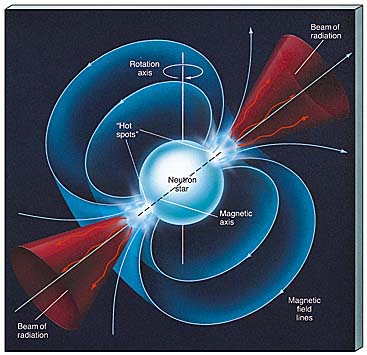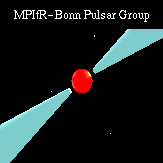|
THE DISCOVERY OF NEUTRON STARS AND PULSARS |
|
1054 |
Chinese astronomer Yang Wei-te reported a "guest
star" (supernova) in constellation Taurus, which was recorded in the
Annals of the Sung Dynasty. Pictographs
from cliff dwellings in Chaco
Canyon are thought to represent the same event.
|
|
1758 |
With a 3.5-inch telescope, while looking for comets, French astronomer Charles Messier discovered a nebulous object in the constellation Taurus. It was later named the Crab Nebula (a.k.a. Messier 1) in the Messier Catalogue. |
|
1930s |
Lev D. Landau (USSR) and F. Zwicky (Switzerland) theoretically predicted the existence of a neutron star. |
|
1933 |
W. Baade and F. Zwicky (California): suggested that supernovae are the sources of cosmic rays, and that a supernova explosion might leave a neutron star behind. |
|
1939 |
J. Robert Oppenheimer published a detailed theory for the structure of a neutron star. But by the mid-1960s, shortly before he died, he had come to believe that there was no way that astronomers could find neutron stars, even if they existed, and he suggested that continued research on the subject was probably a waste of time. |
|
1940s |
W. Baade and others measured the expansion rate of the filaments in the Crab Nebula and showed that they must have originated in an explosion that occurred in about 1054 AD, at the same location in the sky as Yang Wei-te's "guest star." They concluded that the Crab Nebula is the remnant of the 1054 AD supernova. Baade also pointed out a star in the Crab Nebula that appeared to be at the center of the "ripples" moving outward through the nebula, which you can see in this Crab Nebula Movie (source: Space Telescope Science Institute). |
|
1949 |
Australian radio astronomy pioneer John Bolton discovered a strong source of radio emission at the location of the Crab Nebula. |
|
1953 |
Joseph Shklovskii (USSR) suggested that the radio and optical continuum radiation from the Crab Nebula is synchrotron radiation, produced by electrons moving at almost the speed of light in a magnetic field. Such radiation had already been observed on Earth in synchrotrons, magnetic "atom-smashers" designed to accelerate electrons to very high velocities. Shklovskii predicted that the optical light from the Crab Nebula would be polarized. His prediction was confirmed shortly thereafter, as you can see here: polarization of Crab Nebula. This proved Baade and Zwicky's conjecture that supernovae produced cosmic rays. |
|
1964 |
Anthony Hewish (Cambridge, England), using a special radio telescope designed to detect scintillation (twinkling) of compact radio sources, found evidence for a star-like radio source in the Crab Nebula. He did not detect any regular pulsations, however. You can see this star-like source as the bright red spot in these radio images of the Crab Nebula taken with the Very Large Array of radio telescopes. The bright yellow spot is the star-like source. Notice that it is more pronounced at the lower frequency (74 MHz) than it is at the higher frequency (330 MHz). Thirty years later, astronomers observed the X-ray image of the Crab Nebula and found that it had the same shape as the radio image, proving that the pulsar and the nebula radiated X-rays as well as radio emission (see the Multiwavelength Crab Nebula). |
|
1967 |
Jocelyn Bell, using the radio telescope built by Hewish, found the first pulsar, then three more. |
|
1968 |
Australian radio astronomers found a pulsar within the Vela supernova remnant -- the first clear evidence that pulsars were related to supernova explosions. Click here for an X-ray image of the Vela supernova remnant, and here for an optical image. |
|
1968 |
Thomas Gold (Cornell U.) suggested that pulsars emitted radio pulses because they were rotating neutron stars with powerful magnetic fields. The radio source pulsed because the radiation was coming out as a rotating beam. From this idea, he predicted that astronomers should be able to see the pulsation rate slow down, as the magnetic fields converted the energy of rotation into relativistic particles. |
|
1968 |
American radio astronomers found a pulsar in the Crab Nebula with a pulse period of 0.033 seconds. Shortly thereafter, optical astronomers discovered that Baade's star was flashing on and off with the same period. This observation could have been made 30 years earlier if astronomers had thought to look for rapid pulsations in that star. |
|
1969 |
Radio astronomers observed that the Crab Nebula pulsar was slowing down, just as predicted by Gold, proving that pulsars are indeed neutron stars. The rate of slowing down is just what would be expected if the neutron star was formed about 1000 years ago -- i.e., about 1054 AD, the same time as the supernova explosion. |
|
1971 |
American astronomers, using the first orbiting X-ray observatory (called Uhuru), discover an X-ray source that is pulsing with a period of 4.5s. After analyzing the variations in the pulse arrival times they realized that this X-ray source must be a neutron star in a binary star system. The X-rays are emitted when matter from the companion star falls onto the neutron star. Since then, X-ray astronomers have discovered several dozen more such binary X-ray sources containing neutron stars. Observations of their orbits showed that the neutron stars all had masses of about 1.4 solar masses -- the Chandrasekhar limit for a white dwarf star. |
|
1975 |
American radio astronomers discover the first radio pulsar in a binary star system. Subsequent observations of variations in the pulse arrival times show that the pulsar's orbit is changing as predicted by Einstein's general theory of relativity. |
|
1982 |
U. of California Berkeley radio astronomers discover the fastest spinning pulsar, with a rotation period of 0.00156 sec. Unlike the pulsar in the Crab Nebula, it is not slowing down rapidly, indicating an age of more than 200 million years and a relatively weak magnetic field on the neutron star surface. |
|
1994 |
Penn State astronomer Alexander Wolszczan discovers a new pulsar with a rotation period of 0.0062 sec. By carefully analyzing the pulse arrival times, he finds two planets are orbiting this pulsar, with masses 2.8, and 3.4 times the mass of the Earth, respectively (and possibly two more planets). See Pulsar Planets. Now we know of at least one other pulsar with Earth-like planets. See Extrasolar Planets Encyclopedia. |
|
1998 |
Today, more than 700 pulsars have been detected, with periods ranging from 0.00156 to several seconds. Most have been detected only at radio wavelengths, except for several pulsars associated with young supernova remnants that have been observed at optical, X-ray, and gamma ray wavelengths as well. Be sure to check the Princeton Pulsar Page, and don't miss the sounds of pulsars if your PC is set up to receive sound. |

